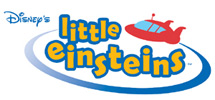
Releases
DISNEY'S LITTLE EINSTEINS™ CURRICULUM OUTLINE
Disney’s Little Einsteins have a mission—to provide three-to-six-year-olds with new ways to enjoy, learn about and make music. Viewers and the lovable band of Little Einsteins characters rocket through a world filled with classical music, celebrated works of art, nature, and real-world images. From the beginning of every episode, preschoolers are encouraged to interact and collaborate with the Little Einsteins team to achieve their goals. The revolutionary use of animation and music in Disney’s Little Einsteins is based on five learning elements—responding to music, listening to music, creating music, music collaboration, and music and art appreciation.
Responding to Music
A great deal of research has been done illustrating the value of teaching preschoolers to keep a steady beat. In fact, studies have linked mastering the steady beat to basic reading skills. Beyond its educational value, the steady beat has a tremendous pleasurable appeal for young viewers who instinctively find it in music and sway to it or pat to it. The steady beat is at the heart of every Little Einsteins episode, providing a natural way to get preschoolers actively involved in the program. For example, the steady beat is used to power up Rocket and viewers are encouraged to pat their laps in unison with the Little Einsteins characters to help Rocket blast off.
Listening to Music
Little Einsteins encourages children to both listen and hear the beautiful layers of classical music that give each piece personality and texture. Children become familiar with expressive musical elements such as dynamics (crescendo, diminuendo), tempo (allegro, adagio), texture (legato, staccato) and pitch (high, low), as classical music pieces are embedded into the physical geography of each story, providing a visual representation of each music concept. For example, a crescendo may be used to help the sun rise and staccato may be represented by a rollercoaster track with three separate pieces of track. Through the creative use of music, preschoolers learn to identify repetition of melodies, rhythms and form in orchestrated music, and instruments.
Creating Music
Preschoolers naturally create and sing new songs all the time, and every episode of Disney’s Little Einsteins encourages them to experience the fun, joy and confidence of singing and making music. Little Einsteins’ unique style of animation marries the music to the visuals—when Rocket flies up a mountain, the musical score reaches a crescendo (growing louder and louder), encouraging viewers to hum or sing along to the melodies of the story. Children also learn to sing variations of a piece of music by humming, “la la”-ing or even “moo”-ing with a herd of cows to spectacular pieces like Beethoven’s “Ode to Joy.”
Musical Collaboration
As the lovable band of Little Einsteins characters work harmoniously together to complete their missions, the musical content gives preschoolers a powerful new way to dramatize the team’s collaborations. For example, when the team helps a group of butterflies go from a quarrelling, fractured crowd to the harmony of butterfly peace, the music helps send a stronger message about conflict resolution than any dialogue ever could.
Music and Art Appreciation
Each episode of Disney’s Little Einsteins features a famous composer and well-known artists and their paintings. At the beginning of every episode, Leo announces the composer of the day. And, during the final curtain call, preschoolers have the opportunity to name—and clap for—the artists and their paintings, as well as for the composer and the music of the day. This provides a cue to parents to the great works of art being featured. For children, after repeat viewing, it provides the names and recognition cues for the music and art they will come to know and love during the series. Today, preschoolers have many opportunities for the thrill of recognition of these celebrated works of art in the real-world, when they suddenly hear “Flight of the Bumblebee” playing in an elevator, hear “Eine Kleine Nachtmusik” in a feature film, or see Van Gogh’s “Starry Night” in a book or museum.
About The Baby Einstein Company
The Baby Einstein Company, LLC, is the award-winning creator of the infant developmental media category. The company is famous for its best-selling Baby Einstein™ brand of videos, books, music CDs and toys specifically designed for babies and toddlers, from birth. Little Einsteins™, debuting in 2005, is the company’s newest venture, specifically created for the preschool market. Headquartered in Glendale, CA, The Baby Einstein Company is a subsidiary of The Walt Disney Company. For more information, visit www.babyeinstein.com or www.littleeinsteins.com.
© 2005 The Baby Einstein Company, LLC. All Rights Reserved. Baby Einstein, Little Einsteins, and the Boy’s Head logo are trademarks of The Baby Einstein Company, LLC. All Rights Reserved. EINSTEIN and ALBERT EINSTEIN are trademarks of The Hebrew University of Jerusalem. All Rights Reserved. www.albert-einstein.org.# # #